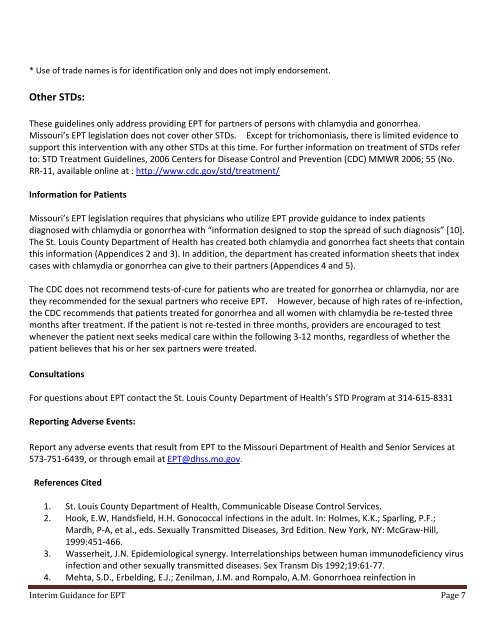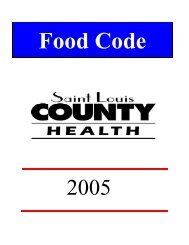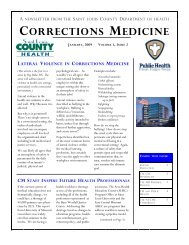Interim Guidelines for Expedited Partner Therapy - St. Louis County
Interim Guidelines for Expedited Partner Therapy - St. Louis County
Interim Guidelines for Expedited Partner Therapy - St. Louis County
Create successful ePaper yourself
Turn your PDF publications into a flip-book with our unique Google optimized e-Paper software.
* Use of trade names is <strong>for</strong> identification only and does not imply endorsement.<br />
Other STDs:<br />
These guidelines only address providing EPT <strong>for</strong> partners of persons with chlamydia and gonorrhea.<br />
Missouri’s EPT legislation does not cover other STDs. Except <strong>for</strong> trichomoniasis, there is limited evidence to<br />
support this intervention with any other STDs at this time. For further in<strong>for</strong>mation on treatment of STDs refer<br />
to: STD Treatment <strong>Guidelines</strong>, 2006 Centers <strong>for</strong> Disease Control and Prevention (CDC) MMWR 2006; 55 (No.<br />
RR‐11, available online at : http://www.cdc.gov/std/treatment/<br />
In<strong>for</strong>mation <strong>for</strong> Patients<br />
Missouri’s EPT legislation requires that physicians who utilize EPT provide guidance to index patients<br />
diagnosed with chlamydia or gonorrhea with “in<strong>for</strong>mation designed to stop the spread of such diagnosis” [10].<br />
The <strong>St</strong>. <strong>Louis</strong> <strong>County</strong> Department of Health has created both chlamydia and gonorrhea fact sheets that contain<br />
this in<strong>for</strong>mation (Appendices 2 and 3). In addition, the department has created in<strong>for</strong>mation sheets that index<br />
cases with chlamydia or gonorrhea can give to their partners (Appendices 4 and 5).<br />
The CDC does not recommend tests‐of‐cure <strong>for</strong> patients who are treated <strong>for</strong> gonorrhea or chlamydia, nor are<br />
they recommended <strong>for</strong> the sexual partners who receive EPT. However, because of high rates of re‐infection,<br />
the CDC recommends that patients treated <strong>for</strong> gonorrhea and all women with chlamydia be re‐tested three<br />
months after treatment. If the patient is not re‐tested in three months, providers are encouraged to test<br />
whenever the patient next seeks medical care within the following 3‐12 months, regardless of whether the<br />
patient believes that his or her sex partners were treated.<br />
Consultations<br />
For questions about EPT contact the <strong>St</strong>. <strong>Louis</strong> <strong>County</strong> Department of Health’s STD Program at 314‐615‐8331<br />
Reporting Adverse Events:<br />
Report any adverse events that result from EPT to the Missouri Department of Health and Senior Services at<br />
573‐751‐6439, or through email at EPT@dhss.mo.gov.<br />
References Cited<br />
1. <strong>St</strong>. <strong>Louis</strong> <strong>County</strong> Department of Health, Communicable Disease Control Services.<br />
2. Hook, E.W, Handsfield, H.H. Gonococcal infections in the adult. In: Holmes, K.K.; Sparling, P.F.;<br />
Mardh, P‐A, et al., eds. Sexually Transmitted Diseases, 3rd Edition. New York, NY: McGraw‐Hill,<br />
1999:451‐466.<br />
3. Wasserheit, J.N. Epidemiological synergy. Interrelationships between human immunodeficiency virus<br />
infection and other sexually transmitted diseases. Sex Transm Dis 1992;19:61‐77.<br />
4. Mehta, S.D., Erbelding, E.J.; Zenilman, J.M. and Rompalo, A.M. Gonorrhoea reinfection in<br />
<strong>Interim</strong> Guidance <strong>for</strong> EPT Page 7
















